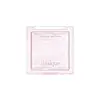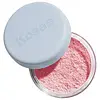What's inside
What's inside
 Key Ingredients
Key Ingredients

 Benefits
Benefits

 Concerns
Concerns

 Ingredients Side-by-side
Ingredients Side-by-side

Magnesium/Potassium/Silicon/Fluoride/Hydroxide/Oxide
Hydrogen Dimethicone
Mica
Cosmetic ColorantTriethoxycaprylylsilane
Hdi/Trimethylol Hexyllactone Crosspolymer
Silica
AbrasiveTalc
AbrasiveDimethicone
EmollientCetearyl Alcohol
EmollientIsopropyl Titanium Triisostearate
EmollientSynthetic Fluorphlogopite
CI 77891
Cosmetic ColorantAluminum Hydroxide
EmollientMethicone
EmollientGlycerin
HumectantPentylene Glycol
Skin ConditioningMagnesium Myristate
Sodium Acrylate/Sodium Acryloyldimethyl Taurate Copolymer
Emulsion StabilisingWater
Skin ConditioningIsohexadecane
EmollientPolysorbate 80
EmulsifyingSorbitan Oleate
EmulsifyingPolysorbate 20
EmulsifyingSodium Dehydroacetate
PreservativeCI 77007
Cosmetic ColorantMagnesium Aluminum Silicate
AbsorbentSorbitan Stearate
EmulsifyingSorbitan Olivate
EmulsifyingEthylhexylglycerin
Skin ConditioningTocopherol
AntioxidantKaolin
AbrasiveCI 73360
Cosmetic ColorantButylene Glycol
HumectantAgave Tequilana Leaf Extract
AstringentCentella Asiatica Leaf Extract
Skin ConditioningSpiraea Ulmaria Extract
AstringentCamellia Sinensis Leaf Extract
AntimicrobialMagnesium/Potassium/Silicon/Fluoride/Hydroxide/Oxide, Hydrogen Dimethicone, Mica, Triethoxycaprylylsilane, Hdi/Trimethylol Hexyllactone Crosspolymer, Silica, Talc, Dimethicone, Cetearyl Alcohol, Isopropyl Titanium Triisostearate, Synthetic Fluorphlogopite, CI 77891, Aluminum Hydroxide, Methicone, Glycerin, Pentylene Glycol, Magnesium Myristate, Sodium Acrylate/Sodium Acryloyldimethyl Taurate Copolymer, Water, Isohexadecane, Polysorbate 80, Sorbitan Oleate, Polysorbate 20, Sodium Dehydroacetate, CI 77007, Magnesium Aluminum Silicate, Sorbitan Stearate, Sorbitan Olivate, Ethylhexylglycerin, Tocopherol, Kaolin, CI 73360, Butylene Glycol, Agave Tequilana Leaf Extract, Centella Asiatica Leaf Extract, Spiraea Ulmaria Extract, Camellia Sinensis Leaf Extract
Mica
Cosmetic ColorantSilica
AbrasiveIsodecyl Neopentanoate
EmollientBambusa Arundinacea Stem Extract
Skin ConditioningBoron Nitride
AbsorbentHydrogenated Vegetable Oil
EmollientC15-19 Alkane
SolventHelianthus Annuus Seed Oil
EmollientTocopherol
AntioxidantCitric Acid
BufferingGlyceryl Undecylenate
EmollientGlyceryl Caprylate
EmollientPentylene Glycol
Skin ConditioningSodium Dehydroacetate
PreservativeCI 19140
Cosmetic ColorantCI 45410
Cosmetic ColorantCI 15850
Cosmetic Colorant
 Reviews
Reviews

Ingredients Explained
These ingredients are found in both products.
Ingredients higher up in an ingredient list are typically present in a larger amount.
Mica is a naturally occurring mineral used to add shimmer and color in cosmetics. It can also help improve the texture of a product or give it an opaque, white/silver color.
Serecite is the name for very fine but ragged grains of mica.
This ingredient is often coated with metal oxides like titanium dioxide. Trace amounts of heavy metals may be found in mica, but these metals are not harmful in our personal products.
Mica has been used since prehistoric times throughout the world. Ancient Egyptian, Indian, Greek, Roman, Aztec, and Chinese civilizations have used mica.
Learn more about MicaPentylene glycol is typically used within a product to thicken it. It also adds a smooth, soft, and moisturizing feel to the product. It is naturally found in plants such as sugar beets.
The hydrophilic trait of Pentylene Glycol makes it a humectant. As a humectant, Pentylene Glycol helps draw moisture from the air to your skin. This can help keep your skin hydrated.
This property also makes Pentylene Glycol a great texture enhancer. It can also help thicken or stabilize a product.
Pentylene Glycol also acts as a mild preservative and helps to keep a product microbe-free.
Some people may experience mild eye and skin irritation from Pentylene Glycol. We always recommend speaking with a professional about using this ingredient in your routine.
Pentylene Glycol has a low molecular weight and is part of the 1,2-glycol family.
Learn more about Pentylene GlycolSilica, also known as silicon dioxide, is a naturally occurring mineral. It is used as a fine, spherical, and porous powder in cosmetics.
Though it has exfoliant properties, the function of silica varies depending on the product.
The unique structure of silica enhances the spreadability and adds smoothness, making it a great texture enhancer.
It is also used as an active carrier, emulsifier, and mattifier due to its ability to absorb excess oil.
In some products, tiny microneedles called spicules are made from silica or hydrolyzed sponge. When you rub them in, they lightly polish away dead skin layers and enhance the penetration of active ingredients.
Learn more about SilicaThis ingredient is a preservative with antimicrobial properties. It is the sodium salt of dehydroacetic acid.
It is especially effective at preventing bacterial and fungal growth in low concentrations.
Tocopherol (also known as Vitamin E) is a common antioxidant used to help protect the skin from free-radicals and strengthen the skin barrier. It's also fat soluble - this means our skin is great at absorbing it.
Vitamin E also helps keep your natural skin lipids healthy. Your lipid skin barrier naturally consists of lipids, ceramides, and fatty acids. Vitamin E offers extra protection for your skin’s lipid barrier, keeping your skin healthy and nourished.
Another benefit is a bit of UV protection. Vitamin E helps reduce the damage caused by UVB rays. (It should not replace your sunscreen). Combining it with Vitamin C can decrease sunburned cells and hyperpigmentation after UV exposure.
You might have noticed Vitamin E + C often paired together. This is because it is great at stabilizing Vitamin C. Using the two together helps increase the effectiveness of both ingredients.
There are often claims that Vitamin E can reduce/prevent scarring, but these claims haven't been confirmed by scientific research.
Learn more about Tocopherol